
The Silurian is a geologic period and system spanning 24.6 million years from the end of the Ordovician Period, at 443.8 million years ago (Mya), to the beginning of the Devonian Period, 419.2 Mya. The Silurian is the shortest period of the Paleozoic Era. As with other geologic periods, the rock beds that define the period's start and end are well identified, but the exact dates are uncertain by a few million years. The base of the Silurian is set at a series of major Ordovician–Silurian extinction events when up to 60% of marine genera were wiped out.
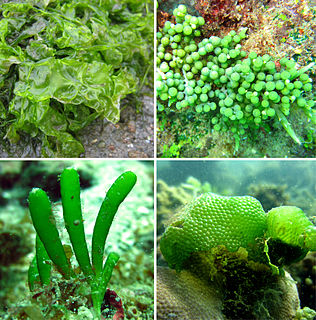
The Ulvophyceae or ulvophytes are a class of green algae, distinguished mainly on the basis of ultrastructural morphology, life cycle and molecular phylogenetic data. The sea lettuce, Ulva, belongs here. Other well-known members include Caulerpa, Codium, Acetabularia, Cladophora, Trentepohlia and Monostroma.

The Queen Elizabeth Islands are the northernmost cluster of islands in Canada's Arctic Archipelago, split between Nunavut and the Northwest Territories in Northern Canada. The Queen Elizabeth Islands contain approximately 14% of the global glacier and ice cap area.

Viridiplantae are a clade of eukaryotic organisms that comprise approximately 450,000–500,000 species and play important roles in both terrestrial and aquatic ecosystems. They are made up of the green algae, which are primarily aquatic, and the land plants (embryophytes), which emerged from within them. Green algae traditionally excludes the land plants, rendering them a paraphyletic group. But it is accurate to think of land plants as kind of alga. Since the realization that the embryophytes emerged from within the green algae, some authors are starting to include them. They have cells with cellulose in their cell walls, and primary chloroplasts derived from endosymbiosis with cyanobacteria that contain chlorophylls a and b and lack phycobilins.
Oltmannsiellopsidales is an order of green algae in the class Ulvophyceae.
Dangemannia is a genus of green algae in the family Oltmannsiellopsidaceae.
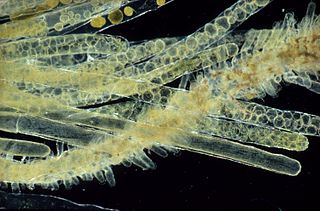
Siphonocladus is a small genus of green algae in the family Siphonocladaceae. The algal body (thallus) is composed of long, club-shaped cells that divide by segregative cell division, followed by the formation of branches that break through the mother cell.

The Nematophyta or nematophytes are a paraphyletic group of land organisms, probably including some plants as well as algae known only from the fossil record, from the Silurian period until the early Devonian Rhynie chert. The type genus Nematothallus, which typifies the group, was first described by Lang in 1937, who envisioned it being a thallose plant with tubular features and sporophytes, covered by a cuticle which preserved impressions of the underlying cells. He had found abundant disaggregated remains of all three features, none of which were connected to another, leaving his reconstruction of the phytodebris as parts of a single organism highly conjectural. No reproductive or vegetative structures common to the land plants are known, and certain members of the nematophyte plexus seem to belong to the fungi.
Chaetocladus is an extinct non-calcifying genus of unicellular green algae known from the Upper Silurian.
Yuknessia is an early pterobranch, known from the Burgess shale, the Chengjiang and the Wheeler shale. Long, unbranched fronds emerge from a central holdfast-like body covered in small conical plates. 23 specimens of Yuknessia are known from the Greater Phyllopod bed, where they comprise < 0.1% of the community. The genus contains two species: the type species Y. simplex and Y. stephenensis. It was originally interpreted as a green alga, and has since been reinterpreted it as a colonial pterobranch.
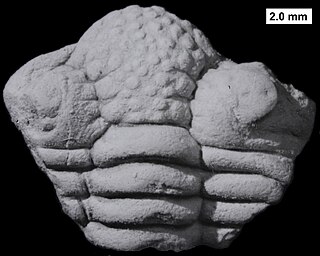
Frammia is a genus of trilobites in the order Phacopida that existed during the middle and upper Silurian in what is now the Arctic regions of Canada and Russia. It was described by Holtedahl in 1914, and the type species is Frammia dissimilis. That species was subsequently considered to be a synonym of Frammia arctica. The genus also contains the species, F. bachae Adrain & Edgecombe, 1997, F. hyperborea, and F. rossica. The type locality is the Douro Formation of Cornwallis Island in Nunavut, Canadian Arctic.
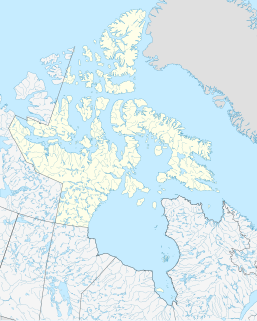
Macormick Bay is an Arctic waterway in Qikiqtaaluk Region, Nunavut, Canada. It lies off the southwestern coast of Devon Island in the eastern high Arctic. Like Baring Bay to the north, it is an arm of Wellington Channel.
Palaeocymopolia is an extinct genus of seaweed in the order Dasycladales, which existed in what is now Cornwallis Island, Nunavut, Northern Canada, during the Ludfordian age. It was described from the Cape Phillips Formation by Steven T. LoDuca, Michael J. Melchin and Heroen Verbruggen in 2011, and the type species is P. nunavutensis.
Chaetocladus capitatus is an extinct species of green algae in the genus Chaetocladus, which existed in what is now Cornwallis Island, Arctic Canada, during the Ludfordian age. It was described by Steven T. Loduca, Michael J. Melchin and Heroen Verbruggen in 2011 based on fossils found in the Cape Phillips Formation.
Michael Coteau is a Canadian politician who serves as the Member of Parliament for Don Valley East in the House of Commons of Canada. From 2011 to 2021, he was a Liberal member of the Legislative Assembly of Ontario representing the provincial district of Don Valley East in Toronto. He served in the Cabinet of Ontario under Premier Kathleen Wynne from 2013 to 2018 in several portfolios, including Citizenship and Immigration, Tourism, Culture and Sport and Community and Social Services. After the 2018 Ontario general election, Coteau was one of seven Liberals re-elected, and he subsequently ran in the 2020 Ontario Liberal Party leadership election, placing second with 16.9% of the vote.

Steven Alfonso Del Duca is a Canadian politician who has been leader of the Ontario Liberal Party since March 7, 2020. Del Duca previously served in the provincial cabinet from 2014 to 2018, first as transportation minister and as economic development minister. He represented the riding of Vaughan in the Ontario Legislative Assembly from 2012 to 2018.

The 2020 Ontario Liberal Party leadership election concluded on March 7, 2020, resulting in the election of Steven Del Duca, a former cabinet minister in the government of Kathleen Wynne, as Ontario Liberal Party’s 33rd leader.
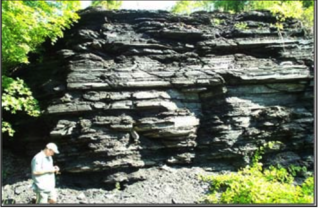
The Medina Group is a geologic group in New York. It preserves fossils dating back to the Silurian period. The group includes the Whirlpool Sandstone, Power Glen Shale, Devils Hole Sandstone, Grimsby Formation, Thorold Sandstone, Cambria Shale and Kodak Sandstone.
The Power Glen Shale is a geologic formation in New York. It preserves fossils dating back to the Silurian period.
Chaetosphaeridiales is an order of green algae.









